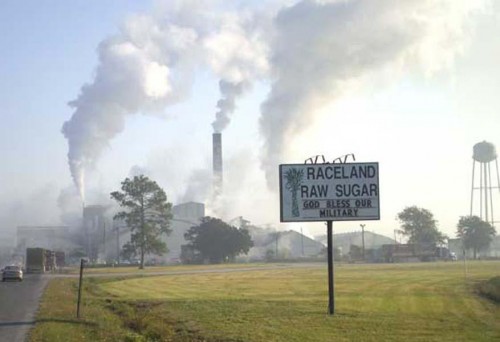
Hazel Abernathy
November 12, 2007Homer Watts, Jr.
November 14, 2007Despite heavy rainfall muddying the opening weeks of sugarcane harvesting season, which began Sept. 27, cane harvesting in Lafourche Parish is running at an average rate similar to last year’s, said Mike Hebert, LSU AgCenter agent for Lafourche Parish.
The parish has two mills, Raceland Raw Sugar and Lafourche Sugar, that have ground 680,000 tons of cane through Oct. 28 to extract the sweet juice, most of which will eventually be crystallized into sugar.
Generally, 48 percent of the cane processed by the two mills comes from acreage in Lafourche Parish.
The AgCenter is projecting that the two mills will grind more than two million tons of cane before the end of the harvesting season, which lasts around 90 days. By early January, south Louisiana gets wetter weather and regular freezes.
“It’s too early in the grinding season to definitely say what the outcome will be, but we’re on par with equaling last year,” Hebert said. “Variables like an early freeze, and excessive rainfall can negatively affect the totals.”
The heavy rainfall early on made hauling clean sugarcane to the mills more difficult. Harvesters and tractors become stuck in the wet soil, bringing in extra mud and leafy trash, the part of the cane plant that is burned during harvesting season.
“There have been some setbacks with recent excessive rainfall, but now we’re in a normal season,” Hebert said. “If conditions are wet, it slows things down.”
“If we can get the weather we’ve had for the past few days,” he said. “We just need the fields to dry out to do a better job of harvesting. We’re looking to get through grinding with sunny, cool weather. It will cut down on harvesting cost and be more efficient on the growers and on the mill side.”
Under Louisiana’s subtropical climate, growers harvest between 30 and 50 tons of cane an acre, which rivals the production found in more tropical climates.
The average yield of sugarcane per acre in the state is 32 to 33 tons.
Following Tropical Storm Isidore and Hurricane Lili, both of which struck Louisiana in 2002, sugarcane growers experienced three consecutive years of diminishing yields.
But they were able to increase production to average levels in 2006.
Though growers and agricultural scientists look at the yield per acre, the real quality of the crop is measured by the sucrose level in the cane. Sucrose is the technical term for sugar extracted from the cane plant.
Mills in Louisiana recover between 175 to 225 pounds of sugar from each ton of cane.
Scientists also look at the amount of sugar produced per acre, which in 2006 in the state was 6,300 pounds, an increase of 754 pounds from 2005.
Dan Duplantis, general manager and chief operating officer of Raceland Raw Sugar, said the mill is grinding around 20 percent more cane than last year.
He said the closure of the St. James Mill in St. James Parish earlier this year has helped boost the amount of cane Raceland is processing.
Duplantis’ company does not grow sugar, but leases adjacent land to cane growers.
Half the cane the company processes comes from Lafourche Parish. It also takes in crops from Terrebonne, Assumption, St. Charles, St. John and St. James parishes.
The company is one-third the way through grinding for this harvesting season.
“The crop has been wet and muddy, but it has gotten better recently,” Duplantis said.
“We’re expecting an average crop,” he said. “The sugar content of the cane is average this year. We’re harvesting about 33 to 34 tons of sugarcane per acre.”
Roughly 28 percent of the total cane crop in Lafourche Parish has been harvested as of late October.
Half the sugarcane acreage in the parish uses the variety called LCP 85-384, released to growers in 1993.
In 2005, the variety covered 89 percent of the sugarcane acreage in the state, which marked the first time any one variety enjoyed such dominance.
Growing a single variety in such abundance, however, leaves the cane vulnerable to common plant diseases like rust and smut.
That is exactly what occurred to LCP 85-384 beginning in 2000. The plant has shown increasing susceptibility to rust disease every year, according to officials.
“Early on in the season, (rust affected) the growth of the cane,” Hebert said. “We had some delayed growth because of that.”
Growers in Lafourche also had to spray for borers – insects or their larvae, which eat away holes in plants – on a farm-by-farm basis this year.
One response to LCP 85-384’s vulnerability to disease has been the introduction of a relatively new, early-maturing variety called L 97-128, released to growers in Louisiana in 2004.
The variety is better at resisting rust and smut.
“We don’t have significant acreage (planted) with that variety,” Hebert said, “but each year there’s an increase in that acreage.”
“There doesn’t appear to be a huge outbreak in that variety,” he said.
L 97-128 also possesses a high sugar yield, especially early in the growing season.
Disease is not the only problem being confronted by cane growers; the leafy trash, or residue, found on all cane stalks needs to be burned away in the open field.
This trash makes up around 20 to 25 percent of the stalk by weight. Burning before harvesting removes 30 to 50 percent of the residue.
The leafy trash has little economic value, and contributes minimally to the production of sugar.
Currently, burning is the only practical way growers can eliminate the residue.
Hebert said all cane farmers take burn-certification classes.
“Wind direction is discussed,” he said. “(Farmers) can burn when the wind direction is favorable. They try to affect as few people and businesses as possible.”
“Farmers have been diligent,” he said. “They watch how they burn. Lately we haven’t been burning because it’s been so wet.”
Burning the cane reduces the amount of soil taken into mills, and lowers fuel use because less material needs to be carried into the mills.
But a recent report issued by the LSU AgCenter stated that cane growers understand that wiping out open-field burning is a priority.
To help eliminate the need for burning, the AgCenter, along with the USDA’s Agricultural Research Service, has been trying to develop economic uses for the leafy trash.
The agencies are also attempting to speed up the decomposition of the residue using biological means, and are trying to develop new cane varieties that drop their leafy trash before harvesting.
“They need sugarcane leaves to grow the cane, but research is being conducted to use the leafy greens,” Hebert said. “It would be to the farmers advantage to use the leafy trash.”
Raceland Raw Sugar’s mill has been working almost non-stop since Sept. 27, the start of the cane harvest season in Lafourche Parish. According to Mike Hebert, LSU AgCenter agent for the parish, this year’s crop should be on with the 2006 figure. * Staff photo by SOPHIA RUFFIN • Tri-Parish Times













